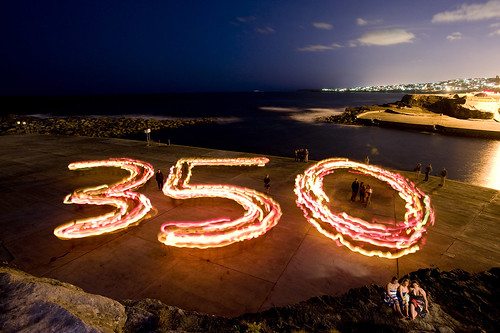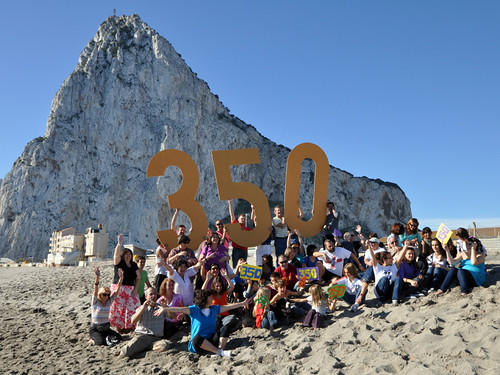(THIS ARTICLE IS MACHINE TRANSLATED by Google from Norwegian)
When the climate summit starts in Copenhagen on December 7, some of the delegates will know extra well where the shoe is pushing. Or maybe we should say where the flippers are – and how the water rises around their legs.
Therefore, the Alliance of Small Island States (AOSIS) is among the initiators of a new campaign that believes that the ambition of a global climate agreement must be to limit global warming to 1,5 degrees. Today, however, it is the so-called two-degree target that is broadly agreed.
- Many politicians gather around the two-degree goal, while more and more scientists show that this is not sufficient to avoid significant sea level rise, says Matt Fitzgerald on the phone to Ny Tid from the US Pacific coast in California.
He is the spokesman for the action which calls itself 350.org.
The campaign includes Grenada Prime Minister Tillman Thomas, leader of the Association of Small Island States, American author Bill McKibben, British author George Monbiot and a number of environmentalists around the world.
The number 350 refers to the amount of greenhouse gases in CO2equivalents the atmosphere can withstand before the temperature rises more than 1,5 degrees. According to climate scientists, it is 350 parts per million (ppm).
Biket in 1989
Throughout history, up to 200 years ago, the concentration of CO2 in the atmosphere was about 275 ppm. While industrialization has led to prosperity growth in parts of the globe, greenhouse gas emissions have also caused the atmosphere today to contain approximately 389 ppm. The limit on 350 ppm was passed in October 1989.
However, politicians who support the two-degree target, such as the Norwegian government, believe that 450 ppm is an acceptable level. Then the emission search does not have to flatten out before in 2015.
- The two-wheeler target is established to create the least common multiple, to try and get everyone involved. But there is so much difference in likely sea level rise due to a 1,5 degree temperature rise and a 2 degree rise that in practice is about whether many island states will be habitable or not in the future, says Matt Fitzgerald.
The Norwegian climate settlement and the Norwegian government believe the two-degree target is good enough.
- The government believes it is very important to have high goals to limit climate change. Limiting the temperature rise to two degrees is already a very ambitious goal, says political adviser in the Ministry of the Environment, Audun Garberg, to Ny Tid.
He points out that the UN Climate Panel has investigated the possibilities of reducing greenhouse gas emissions in its latest main report, and that the most ambitious goal they have investigated is to limit the temperature rise to two degrees.
- Growth in global emissions must then be reduced to reductions by 2015, and then emissions must be reduced by between 50 and 85 per cent globally. For industrialized countries, this will mean emission reductions of 80 to 95 per cent, compared with the level in 1990. We have also emphasized that it should be feasible to limit warming to this level, both technically and politically. Only during the past year have several analyzes been presented that show that it is possible to reach the two-degree target. The two-wheeler target has received increasing support, and most recently this summer recognition from the Major Economies Forum, where major developing countries such as China are also participating, says Garberg.
- No room
- The atmosphere doesn't have room for more greenhouse gases, it's that simple. If a global climate agreement does not become more ambitious than the two-degree target, this will be the first time a worldwide body decides to put someone under water, says Matt Fitzgerald.
The head of the UN Climate Panel, Rajendra Pachauri, said the following on 350.org's website:
"As chairman of the UN Climate Panel (IPCC), I cannot make any recommendations. But as a human being, I fully support the 350 ppm limit ”.
The goal of limiting the concentration to 350 ppm originally comes from a report prepared by Dr. James Hansen, a researcher at NASA. The report was published at the beginning of 2008 and is called "Target CO2: Where Should Humanity Aim? »
Up to the beginning of the 1990 century, many researchers used 550 ppm as a starting point, since this was twice the pre-industrial level, making it easy to use as a starting point for models. As time went on, it became clearer that the threshold had to be lowered, and many began operating with 450 ppm, or two degrees centigrade, as the target. But also these were guesses, not based on actual experience.
During summer 2007 came alarming reports of ice melt in the Arctic, and it became clear to James Hansen that we had already crossed a border. A number of other signs pointed in the same direction: a peak in methane emissions, probably from permafrost melting, and rapid and unexpected acidification of seawater. All of these signs indicate the same, Hansen thinks: No matter where the red danger line goes, we are already past it, even though the atmospheric concentration of CO2 only is 390 ppm.
Therefore, Hansen writes that 350 parts per million CO2 is the upper limit, if we want to have a planet "similar to the one on which civilization evolved and on which life on earth is adapted". A steady stream of new reports supports this conclusion. Last week, a new report came from marine scientists, which shows that long-term atmospheric levels above 360 ppm will destroy coral reefs worldwide.
- 350 is the most important number in the world, and I would urge everyone in Norway to learn what this number entails, concludes Matt Fitzgerald. ■




